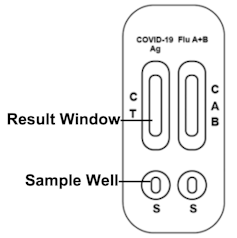Author: Thea van de Mortel, Griffith University
If you have respiratory symptoms as we head towards winter and flu season, could it be COVID or the flu? Or something else entirely?
Now, we have a range of home tests that can distinguish between flu and COVID with one swab. They use technology you might be used to. They’re rapid antigen tests or RATs.
Here’s what you need to know about the tests, why they might be useful, and what they don’t tell us.
What’s new about these tests?
Most people were introduced to RATs while testing at home for COVID.
But RATs to detect the flu have been available for years, albeit used by health workers to test patients.
The latest RATs are different for two reasons. One, they detect both COVID and flu with one swab (a “combo” test). Two, they can be used at home.
The first of these combo home tests for flu/COVID was approved in September 2022. Now several are on the market.
These tests let you check, with one test kit, if you are infected with two types of flu (influenza A and B) and SARS-CoV-2 (the virus that causes COVID).
How do they work?
These RATs contain antibodies that can detect influenza A, influenza B, and SARS-CoV-2.
Some kits have a test cassette with one well to add drops to and one window labelled: C (control), A (influenza A), B (influenza B) and T (test for COVID).
Some tests have two wells and two test windows. You view the influenza results in one window and the COVID results in the other.

Some test cassettes have two wells, like this one. TGA
In the influenza window you will see markings C, A and B. If a line becomes visible at A (and C), you have tested positive for influenza A. If a line becomes visible at B (and C), you are positive for influenza B. If lines are visible at A, B and C you have tested positive for both influenza A and B.
If either A or B has a line but not C, or if none of them do, the test is invalid and you will need to take a new one.
The COVID window works the same way as in a standard RAT for COVID. If a line becomes visible at C and T, you are COVID-positive. If there is a line at C but not T, you are COVID-negative. If there is no line at C the test is invalid.
Why take the test? 3 reasons
If you have respiratory symptoms, there are some practical reasons for knowing whether you are positive for COVID or flu.
One, if you know you have COVID, this will affect the timing of your booster vaccine. The Australian Technical Advisory Group on Immunisation recommends adults wait six months after a COVID infection to get a booster to increase the time you have protective immunity. So it helps to know if you have been infected.
Two, if you need antiviral treatment, the medications differ depending on whether you have flu or COVID.
Three, knowing you have flu or COVID means you can take steps to protect others. This could mean working at home, avoiding contact with vulnerable people, and wearing a mask in company.
Which test to use? When to use it?
The Therapeutic Goods Administration (TGA) lists approved tests on its website. Type the term “combination” in the search box. All combo tests currently listed use nasal swabs to collect the sample.
Most are listed as “very high sensitivity”. This means they get the same result in detecting positive cases as the gold standard PCR test 95% of the time. The others have “high sensitivity” (90% agreement with a PCR).
The best time to take the test is within four days of developing symptoms, as this is when it is easiest to detect both flu and COVID. The tests are more reliable if you have symptoms.
What if I have symptoms but the test is negative?
One possibility is that your viral load was not high enough to be detected. You could take another test a day or so later to check again.
Another is you may have a different virus. Viruses that cause respiratory symptoms include rhinoviruses, adenoviruses, respiratory syncytial virus and common cold coronaviruses.
Other pathogens (disease-causing microorganisms) or health conditions can also cause respiratory symptoms. If you are concerned, consult your doctor for medical advice.
What else should I know?
As each test differs, make sure you follow the instructions for that specific test.
The price of combo kits advertised online varies from A$8.95 to $59 (excluding delivery) so it pays to shop around.
It’s worth trying to avoid catching the flu rather than testing for it later. Flu vaccination reduces your chances of catching the flu by 40-60% when the vaccine is well matched to circulating strains. Flu vaccines for the 2023 flu season are available now.
Thea van de Mortel, Professor, Nursing, School of Nursing and Midwifery, Griffith University. This article is republished from The Conversation under a Creative Commons license. Read the original article.
All images are for illustrative purposes only and sourced from stock photo sources.
